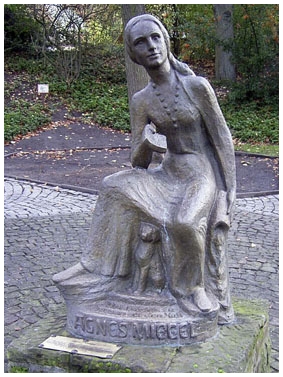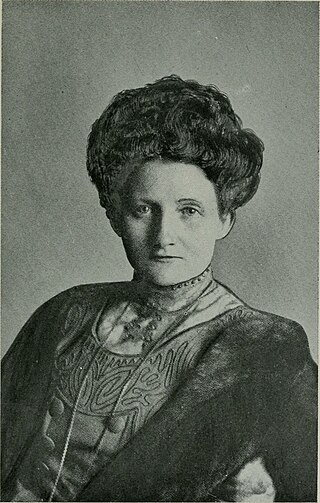
Friedrich David Gilly was a German architect and the son of the architect David Gilly. His works are influenced by revolutionary architecture (Revolutionsarchitektur). Born in Altdamm, Pomerania,, Gilly was known as a prodigy and the teacher of the young Karl Friedrich Schinkel.

Agnes Miegel was a German author, journalist and poet. She is best known for her poems and short stories about East Prussia, but also for the support she gave to the Nazi Party.
Die Tat was a German monthly publication of politics and culture. It was founded in April 1909 and its publisher was Eugen Diederichs from Jena. From 1939 until 1944 Die Tat was continued as Das XX. Jahrhundert.
Gerd Zacher was a German composer, organist, and writer on music. He specialized in contemporary compositions, many of which feature extended techniques, and are written in graphic or verbal scores. He interpreted the scores of numerous contemporary composers, including John Cage, Juan Allende-Blin, Mauricio Kagel, György Ligeti, Hans Otte, Luis de Pablo, and Isang Yun. He is also known as an interpreter of the works of Johann Sebastian Bach.
Heinrich Ludwig Julius Heppe was a German Calvinist theologian and church historian.

Marcus Junkelmann is a German historian and experimental archeologist.

Walter Kaufmann was a German-Australian writer.
Dominik Schröder was an ethnologist whose researches were focused mainly in the Moungor (Tu) people of Northwest China. He was born in Eiweiler, in the Nohfelden municipality of the Saarland. He worked as a missionary in China from 1938 to 1949. He obtained an MA from Fujen University in Beijing in 1945.

The Rostock Art Gallery was opened on 15 May 1969 as a museum of contemporary art in Rostock in the German federal state of Mecklenburg-Vorpommern. It is in the grounds of the park around the Schwanenteich lake in the quarter of Reutershagen.
Kyra T. Inachin was a German historian.

Heimkehrer refers to World War II German prisoners of war and internees—Wehrmacht (Heer), Kriegsmarine, Luftwaffe, Waffen-SS, Ordnungspolizei, behind-the-lines Hiwi security and civilian personnel—who were repatriated to West Germany, East Germany and Austria after the war. Some of the late returnees were convicted war criminals who were subsequently tried in West Germany.

Ernest Wichner is a German writer, editor, and literary translator of Banat Swabian origin.

Andreas Heusler was a Swiss philologist who specialized in Germanic studies. He was a Professor of Germanic Philology at the University of Berlin and a renowned authority on early Germanic literature.

Helmut Müller-Enbergs is a German political scientist who has written extensively on the Stasi and related aspects of the German Democratic Republic's history.
Friedrich Wilhelm Karl Ritter von Hegel was a German historian and son of the philosopher Georg Wilhelm Friedrich Hegel. During his lifetime he was a well-known and well-reputed historian who received many awards and honours. He was one of the major urban historians during the second half of the 19th century.
Georg Stenger is a German philosopher and professor and chair of the department of philosophy at the University of Vienna. He is known for his works on structural ontology, intercultural philosophy, Heidegger's philosophy and also his contributions to Heidegger Gesamtausgabe. Stenger is the president of Society of Intercultural Philosophy.
The Deutsches Rechtswörterbuch (DRW) or Dictionary of Historical German Legal Terms is a historic legal dictionary developed under the aegis of the Heidelberg Academy of Sciences and Humanities. The research unit took up work in 1897 and until today has completed 93,155 articles, ranging from Aachenfahrt to selbzwölft. These have been published in 12 consecutive volumes and are also freely accessible online. In course of its research, the DRW also touches upon sources in Old English, of Hanseatic provenance and Pennsylvania German. The research unit will presumably conclude its work in 2036.
Leonhard Sigmund Friedrich Kuno Klaus Schultze-Jena was a German explorer, zoologist, and anthropologist known for his explorations of German Southwest Africa and New Guinea, as well as for his studies on Mesoamerican languages. During the Herero and Namaqua genocide, Schultze, a witness, took "body parts from fresh native corpses" which according to him was a "welcome addition". He also noted that he could use prisoners for that purpose.

Eugen Fehrle was a German philologist who specialized in classical and Germanic philology.

Lulu von Strauss und Torney (1873–1956) was a German poet and writer. Best remembered for her ballads, she also wrote historical fiction with rural settings in northwest Germany.
This page is based on this
Wikipedia article Text is available under the
CC BY-SA 4.0 license; additional terms may apply.
Images, videos and audio are available under their respective licenses.










